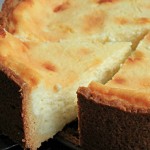German Cheesecake (Käsekuchen)

This wonderful and creamy German Cheesecake is very light and each bite melts in your mouth. It is not too sweet. This is a dessert that always gets many wonderful compliments.
Source: Diana’s Recipe Book blog
Serves: 12
Ingredients
- For the Crust:
- 1 ½ cups all-purpose flour
- 1 teaspoon baking powder
- A pinch of salt
- 2 teaspoons vanilla-sugar
- 1 tablespoon finely grated lemon rind
- 1 egg, beaten
- ¼ cup granulated sugar
- ¾ stick (7 tbsp./3 ½ oz./100g) butter
- For the Filling:
- 3 egg yolks
- ¾ cup granulated sugar
- 2 teaspoons vanilla-sugar
- ¾ stick (7 tbsp./3 ½ oz./100g) butter, very soft and at room temperature
- 6 oz. heavy cream
- 17 oz. (500g) Quark - A light yogurt type cream cheese* (see note below for Quark substitutions, if needed)
- 1 ½ tbsp. cornstarch
- 3 egg whites
- ¾ cup raisins
- Pinch of salt
Directions
- For the Crust:
- Sift the flour, stir in the baking powder, salt, vanilla-sugar, lemon peel and sugar, then rub in the butter and knead to a smooth consistency with the egg. Place dough in a plastic bag in the refrigerator for 1 hour.
- Preheat oven to 300 degrees F (150 C). You will need a 9 or 9½-inch spring form pan.
- Roll out the dough on a well-floured work surface, then form it into a ball again and roll it out a second time. (This dough is the worst behaved of any I have ever had to deal with, but the double rolling helps tame it, and the end result IS worth the hassle). Place dough in bottom of a 9 or 9½-inch spring form pan, pressing it up the sides almost to the top. An alternate way to line the pan is to Roll out the dough: Using ⅔ of the dough, roll out a circle big enough to cover the bottom of a 10 inch springform pan. Roll the remaining dough into a rope, flatten with a rolling pin and line the sides of the pan. Where the bottom meets the sides use some water and pressure to seal. Set aside.
- For the Filling:
- Beat the egg yolks with the sugar and vanilla-sugar until pale and foamy. Add the softened butter and beat well, then add the heavy cream and beat again. Add the quark and stir until the mixture is smooth and thoroughly combined.
- Whisk the egg whites with the salt until very stiff, then very gently fold in the quark mixture, also adding the sifted cornstarch a little at a time. Fold in the raisins. Pour the filling into the crust shell and gently wobble the pan back and forth until the surface is smooth. Trim the dough, leaving about 1 inch (2½ cm). Bake in preheated 300 degrees F (150 C) oven for 50 to 60 minutes (longer if necessary) until well risen and golden - it resembles a soufflé at this point (It will sink in the middle quite dramatically - don't worry, it's supposed to do this). Turn the oven off, and let the cheesecake rest in the oven for 15 minutes; then remove it from the oven, cool for an hour or so at room temperature, and refrigerate for several hours before releasing sides of pan and serving. (I make mine the day before I need it). This cheesecake is very nice served with sliced strawberries, or a raspberry sauce. Keep cheesecake stored in the refrigerator, covered.
Notes
There are 3 substitutions that can be used for the Quark in this recipe if Quark is not available. One is to use farmer’s cheese, another is to purée cottage cheese in a blender or food processor, and the third is to purée eight parts of ricotta cheese with 1 part of sour cream in a food processor. Tips: Crust should seal so that there is little or no leakage. Use a bit of cold butter between the pan and dough to help it stay upright and build up the sides so that they are thicker on the bottom, thinner at the top.
Recipe by Recipes to Try at https://recipestotry.ca/german-cheesecake-kasekuchen/